
PeRsIaN CeLebRaTiOn's
 by:[Black Raven]
by:[Black Raven]
Shabe Yalda:The Winter Feast
It's the longest night of the year.The Shabe Yalda is the 30th of the month Azar (21 Dec). Yalda means
birth and it's related to the birth of Juses.
Traditionally on this night the forces of Ahriman (devil) are at the peak of their strength. The next day, the first day of the month of ‘Dey’ known as ‘khoram rooz’ or ‘khore rooz’ (the day of sun) belongs to Ahura Mazda, the Lord of Wisdom. Since the days are getting longer and the nights shorter, this day marks the victory of Sun over darkness.
On this night, the family gather for a large feast. Various dried fruits, nuts, seeds and fresh winter fruits are provided at these events to celebrate and pray to the deities to ensure the protection of the winter crops.
Medieval poetry from
Hafiz can be read and fortunes are told in the famous “Fal-e Hafez” tradition.
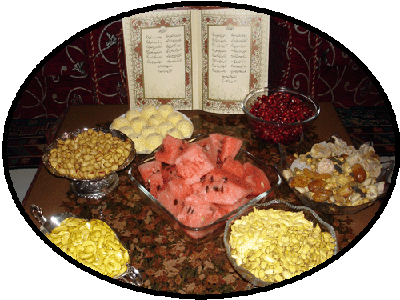
4Shanbeh Suri:Red Wednesday Bonfire Festival
In the evening of the Wednesday before Norooz (last Wednesday of the year), the Iranians celebrate 4Shanbeh Suri. The word 4Shanbeh means
Wednesday and Suri means
red.The festivities start in the early evening.
Young people, children and everybody who are seeking fun run through the streets banging on pots and pans with spoons. This is called Gashog-Zani or spoon banging, and ushers out the last unlucky Wednesday of the year. They also go to their neighbours, knock on doors and ask for treats, a tradition very similar to Halloween.
The main event of 4Shanbeh Suri is the setting of seven little fires. Adults and children alike gather to jump over the flames to sing, and celebrate the renewal of life. While jumping the flames, the person chants “Sorkhi-e to az man. Zardi-e man az to.” The literal translation is, “Your fiery red colour is mine and my sickly yellow paleness is yours.” Loosely translated, this means you want the fire to take your paleness, sickness and problems and in turn give you redness, warmth and energy.
There is no religious significance attached to Chahar Shanbeh Suri and it serves as a cultural festival for all Iranian Jews, Muslims, Armenians, Turks and Zoroastrians alike.
This ancient festival has been celebrated for thousands of years ever since the birth of the Zoroastrian religion in Persia.
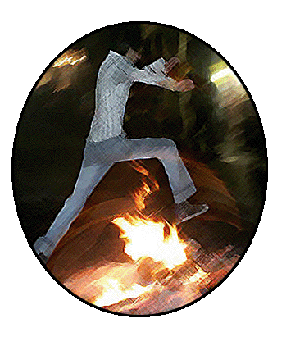
Norooz:New Year
No means
new and
Rooz means
day so
Norooz means
new day. It occurs exactly on the Spring Equinox. This occasion has been renowned in one form or another by all the major cultures of ancient Mesopotamia. Sumerians, 3000 BC, Babylonians, the ancient kingdom of Elam in Southern Persia and Akaddians in the second millennium BC, all celebrated this festival. What we celebrate today as Norooz been around for at least 3000 years and is deeply rooted in the rituals and traditions of the Zoroastrians of the Sassanian period.
The term Norouz first appeared in Persian records in the second century CE, but it was also an important day during the Achaemenid times (c. 648-330 BCE), when kings from different nations under Persian empire used to bring gifts to the emperor (Shahanshah) of Persia on Norooz. It has been suggested that the famous Persepolis complex, or at least the palace of Apadana and the "Hundred Columns Hall", were built for the specific purpose of celebrating Norouz. However, no mention of Norouz exists in Achaemenid inscriptions.
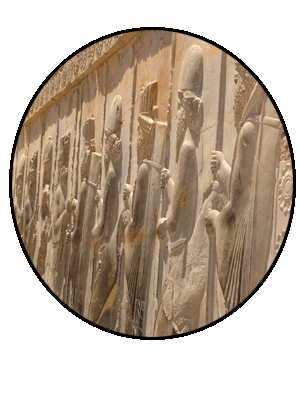
The Sal Tahvil or the Sa'at-e Tahvil is New Year's Eve, which is the official time for the Spring Equinox. Every year the equinox occurs at a different point in time, so the date, although accurately measured (to the date and time) is different each year, but close to March 20th (Norooz 2007, 2008 and 2009 are on the 21st of March). at this time we kiss and forgive each other, and the parents and family give children Eidy. Eidy is some money that is placed in a Koran book.
Haji Firuz & Amoo Norooz: The Persian Troubadour & Santa Claus
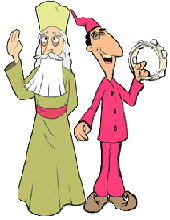
Haji Firooz is symbol of happiness,he has a red dress and red hat and black face,he dance and sing in the streets, and do funny things. Amoo Norooz, a distant relative of Haji Firooz is responsible for giving gifts to the children much like Santa Claus. He tells stories for childeren and ensures that they are happy and healthy for many years to come.
Sofre 7sin:seven's s
The Sofreh Haft Sin (Haft Seen) is the spread, which the family gathers around to celebrate the New Year.
from 2 or 3 weeks before Norooz every bidy try to prepare this things. Childeren colour the eggs, and parents prepare Spring Sprouts.
the items of 7 Sin are:
Sabze: Spring Sprouts
Senjed: A sweet, dry fruit of a lotus tree (The fragrant and blooming lotus tree makes people fall in love so it is natural that its fruit would signify love and affection)
Samano: Wheat Pudding(sweetness)
Sib:Apple(symbol of health and beauty)
Sekke: Gold Coins(Prosperity )
Somagh: Crushed Sumac berries(represents the color of the sunrise)
Serke: Vinegar(signifies age and patience)
Sonbol: Hyacinth Flower(represent life and beauty)
Seer: Garlic (good health)
and a little red fish
Yes, it's more than 7 but you could choose 7 of these or put them all in the Sofre (spread).
The other things for 7 Sin is candles, raw rice, colored eggs, mirror and Koran.
Norooz: This holiday has 13 days, in this days everybody goes to their family home and visit their family this is Did O Bazdid.
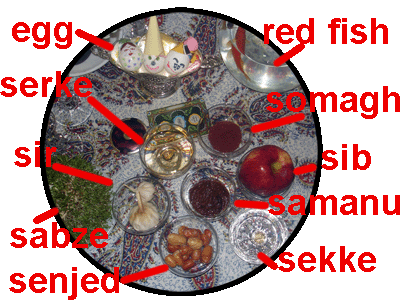
13 Bedar:13 away
Seezdah Bedar is the last holiday of the long Norooz break and is a day filled with relaxation and fun outdoors. Seezdah means 13 and
Bedar means
away or
outside. Iranians consider 13 to be an unlucky number and so for this reason, they spend the 13th day of the New Year outside the home. Seezdah-Bedar is in essence a national picnic that is celebrated with everyone going to parks, hills and mountainsides to spend the day with nature, wishing the evil spirits away. This way one hopes to avoid that any bad incidents that may occur.
More importantly, the sabzeh (sprouted wheat or lentils) is brought from the sofreh Haft-Sin to be thrown in a flowing stream or creek. It is believed that the sabzeh, which has by this time turned a little yellow, symbolizes sickness and problems. Therefore, it is thrown and carried away by the stream.and let red fish go in the rivers.
In addition, Seezdah Bedar is a big day of hope, and people who wish for things follow the tradition of tying grass together. For example if a young girl wishes to find a husband in the coming year she will tie grass. There are various chants for people who wish to get a job or be healthy or wealthy and so on. At the end of this day, the haft sin may be cleared away and families return to work.
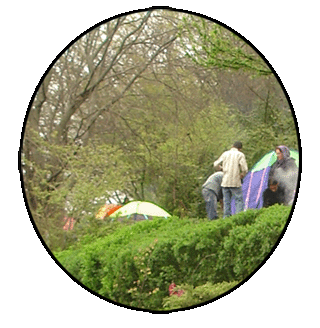
That was a little about some of our celebrations, I wish you enjoyed it!

I did a search on Google and found these sites. these are good for further information about the subject:
http://www.persianmirror.com/celebrations/persiancelebrations.cfm
http://en.wikipedia.org/wiki/Norooz
Image of Amoo Norooz & Hjai Firooz from:
http://www.babakandfriends.com/babak/
 Stumble!
Stumble!




 Haji Firooz is symbol of happiness,he has a red dress and red hat and black face,he dance and sing in the streets, and do funny things. Amoo Norooz, a distant relative of Haji Firooz is responsible for giving gifts to the children much like Santa Claus. He tells stories for childeren and ensures that they are happy and healthy for many years to come.
Haji Firooz is symbol of happiness,he has a red dress and red hat and black face,he dance and sing in the streets, and do funny things. Amoo Norooz, a distant relative of Haji Firooz is responsible for giving gifts to the children much like Santa Claus. He tells stories for childeren and ensures that they are happy and healthy for many years to come.







